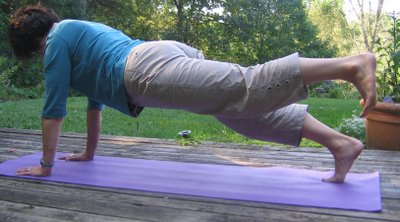
In honor of Talk Like a Pirate Day (September 19) I want to focus this week’s posting on Plank Pose. Like Adho Mukha Svanasana (Downward Facing Dog) or Navasana (Boat Pose), Plank pose is an efficient, all-body pose that strengthens the arms, torso and legs. It’s not easy, but it is a good pose to drop into if you only have a few minutes to dedicate to yoga on a particular day (ouch, busy day). It is also very adaptable, so you can change the position of the arms and legs to make the pose harder, easier or just to change the emphasis. Here are some variations:
Variations for Plank Pose
Basic Plank: Set up in Table Pose as you would for Dog; heels of the hands are beneath the shoulders, knees are beneath the hips. From here, straighten the arms and stretch the legs out behind to bring the torso into a straight line from the ankles to the shoulders. Keep the shoulders away from the ears and the neck long. Notice the work in the torso--the abdominals do most of the work in this pose, more than the arms and legs, because they are responsible for keeping the spine long and the torso lifted. If your hips sag, or the body is bent, lower one or both knees to the floor, so that the abs are still engaged, but you can lengthen the back. Try to hold for 5 breaths and work up to 10.

One-Legged Plank: In this version (in keeping with the Pirate Day theme), come into the Basic Plank and then lift one heel. Keep the weight balanced between both hands and stretch out thru the lifted heel. This requires even more work from the torso, so don’t try it if you need do the Basic Plank with one knee on the floor.
Tripod Plank: Make a tripod by interlocking the fingers, bending the elbows and resting the forearms on the floor with the elbows under the shoulders. Then lift the torso and straighten the legs. This version works the upper chest and triceps.

Ball Plank: If you want to take your Plank to an even more challenging level, try it on an exercise ball. Come into the Basic Plank with the legs resting on the ball, and walk your hands forwards until the lower shins and ankles are on the ball, while the shoulders are over the wrists. Notice how you have to engage the side body to keep your balance on the ball—this is in addition to the work that keeps the hips lined up with the legs. Arrgghh!
©Brenda K. Plakans. All Rights Reserved.







No comments:
Post a Comment